Bicycles play a vital role in sustainable urban transportation by offering a clean, affordable, and accessible way to get around. They help reduce emissions, improve air quality, and decrease traffic congestion. Cycling also promotes healthier, more active communities and connects seamlessly with public transit systems. Cities worldwide are adopting innovative infrastructure and policies to support bike use and community engagement. Keep exploring to discover how cycling can transform your city’s future.
Key Takeaways
- Bicycles produce zero emissions, reducing urban air pollution and greenhouse gases, supporting climate change mitigation.
- Cycling infrastructure and bike-sharing systems enhance urban mobility, alleviate traffic congestion, and promote active transportation.
- Bicycles provide equitable access, supporting vulnerable populations and fostering inclusive, safe, and accessible transportation options.
- Innovations like e-bikes and smart infrastructure expand cycling’s role, making it a versatile and efficient urban transport mode.
- Community engagement and policy initiatives, exemplified by cities like Copenhagen and Bogotá, strengthen cycling’s contribution to sustainable cities.
Environmental Benefits of Cycling in Cities
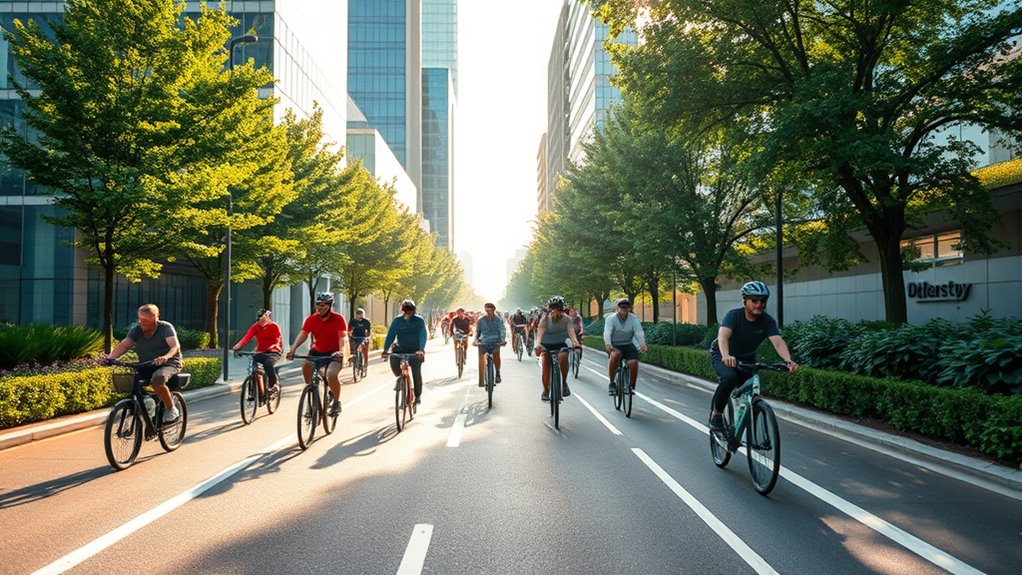
Cycling in cities offers clear environmental advantages by producing zero emissions during operation. When you choose to cycle, you help reduce greenhouse gas emissions that typically come from motorized vehicles, making urban environments cleaner. Cycling also plays a pivotal role in improving air quality by replacing car trips that emit pollutants and particulate matter. As more people adopt cycling, the overall carbon footprint of urban transportation decreases, supporting climate change mitigation efforts. Developing cycling infrastructure encourages eco-friendly travel options, decreasing reliance on fossil-fuel-powered vehicles. Additionally, cycling lowers noise pollution, creating a healthier, more sustainable city atmosphere. Incorporating low light office plants into urban spaces further enhances air purification and overall environmental quality. Promoting sustainable transportation methods like cycling is essential for achieving long-term urban environmental goals. By integrating cycling into urban life, you contribute directly to a greener environment, enhancing the quality of life for everyone in your city.
Enhancing Urban Mobility and Accessibility

By choosing to ride a bicycle, you not only reduce pollution but also improve how easily people can move around the city. Cycling enhances urban mobility by providing a reliable, zero-emission option that alleviates traffic congestion. Investing in cycling infrastructure—like protected bike lanes and bike-sharing systems—significantly boosts accessibility, allowing more residents to incorporate active mobility into their daily routines. This shift encourages the integration of cycling with public transportation, creating seamless travel options. Cities with extensive cycling networks, such as Copenhagen and Bogotá, demonstrate how improved infrastructure promotes social inclusion and bridges accessibility gaps. Additionally, growth mindset among city planners and communities can facilitate innovative solutions for enhancing cycling infrastructure and adoption. Implementing effective urban transportation strategies can further support the expansion of cycling networks and improve overall city planning. Recognizing the importance of store hours and how they impact access and convenience can also inform better urban planning decisions. Developing cycling infrastructure and promoting community engagement are essential steps toward more sustainable urban environments. By supporting cycling, you help foster a more connected, efficient city where everyone benefits from enhanced urban mobility and easier access to essential services. Encouraging innovative solutions can further accelerate the development of effective cycling networks and policies.
Promoting Equity Through Inclusive Infrastructure
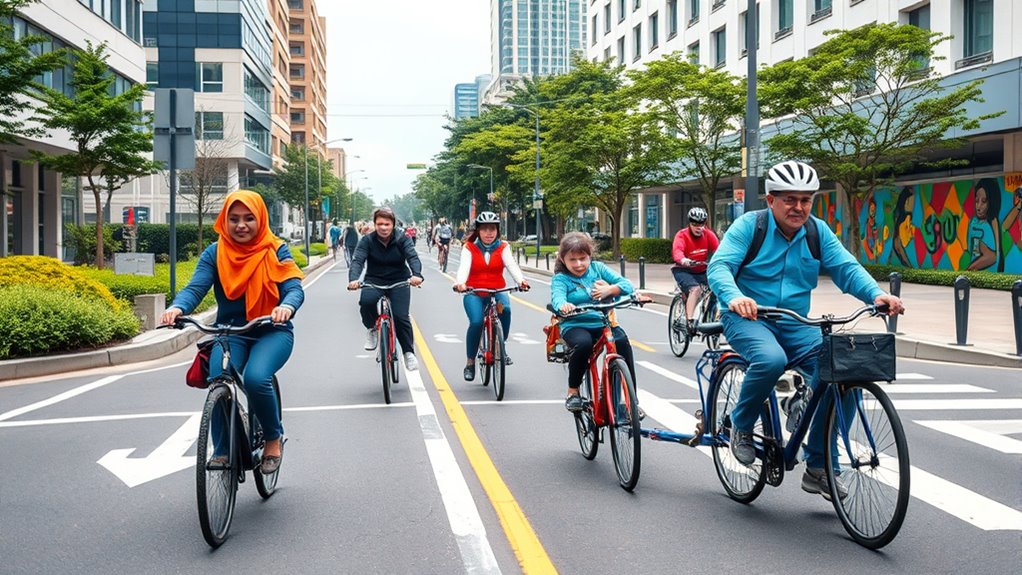
Inclusive bicycle infrastructure plays a vital role in ensuring that everyone has safe and equitable access to active transportation options. Protected bike lanes and universal design standards help remove barriers for vulnerable populations like women, children, the elderly, and disabled individuals. Cities such as Bogotá, with extensive cycling networks, demonstrate how inclusive infrastructure supports diverse communities and promotes social equity. Addressing safety concerns and sharing road space through policies that prioritize protected lanes reduces disparities faced by underserved communities. Community participation, via neighborhood Bike Councils and active citizen input, helps tailor infrastructure to local needs. Structural approaches like complete streets and temporary separated bike lanes make cycling safer and more appealing, ensuring equitable mobility for all urban residents. Regularly assessing and improving infrastructure can also help meet evolving community needs, including equity in transportation access. Incorporating filtration systems into bike infrastructure can also improve air quality for cyclists and pedestrians alike. Additionally, integrating air filtration features into cycling pathways can significantly reduce pollution exposure in densely populated areas.
Innovations and Trends in Urban Bicycling
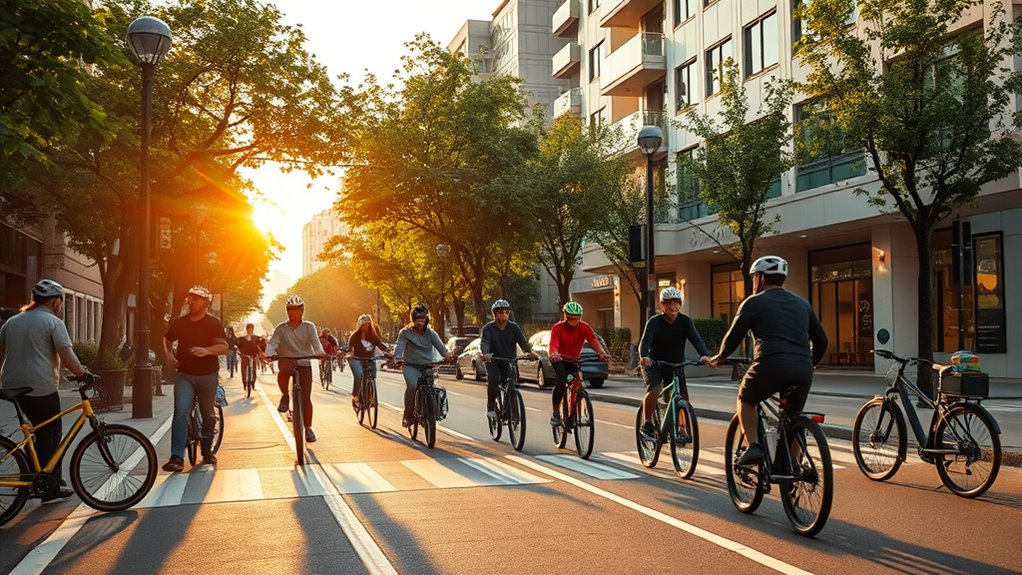
Innovations in urban bicycling are transforming how cities embrace active mobility, making cycling safer, more convenient, and more versatile. The rise of e-bikes and cargo bikes expands urban cycling’s reach, supporting commuting, logistics, and family trips. Micromobility solutions like e-scooters and bike-sharing systems are seamlessly integrated into bicycle infrastructure, boosting accessibility and reducing congestion. Cities are adopting innovative urban design, such as superblocks and protected lanes, to prioritize cyclists. Smart bike lanes now feature dynamic signaling, app-based monitoring, and data systems that enhance safety and efficiency. These developments reflect a shift toward more sustainable, adaptive urban environments that encourage active mobility and reduce carbon footprints. Advanced bicycle infrastructure with protected lanes and stations, smart, data-driven urban cycling systems, expansion of e-bike and cargo bike models, and integration of micromobility into city planning. Additionally, the implementation of urban data systems allows for real-time adjustments and improved traffic management, fostering a safer environment for cyclists. Incorporating cycling-friendly urban design principles further supports this shift by creating more attractive and functional environments for cyclists. Furthermore, understanding human-centered design principles can help optimize cyclist safety and comfort, encouraging more residents to choose biking as their primary mode of transportation.
Policy Initiatives Supporting Bicycle Adoption
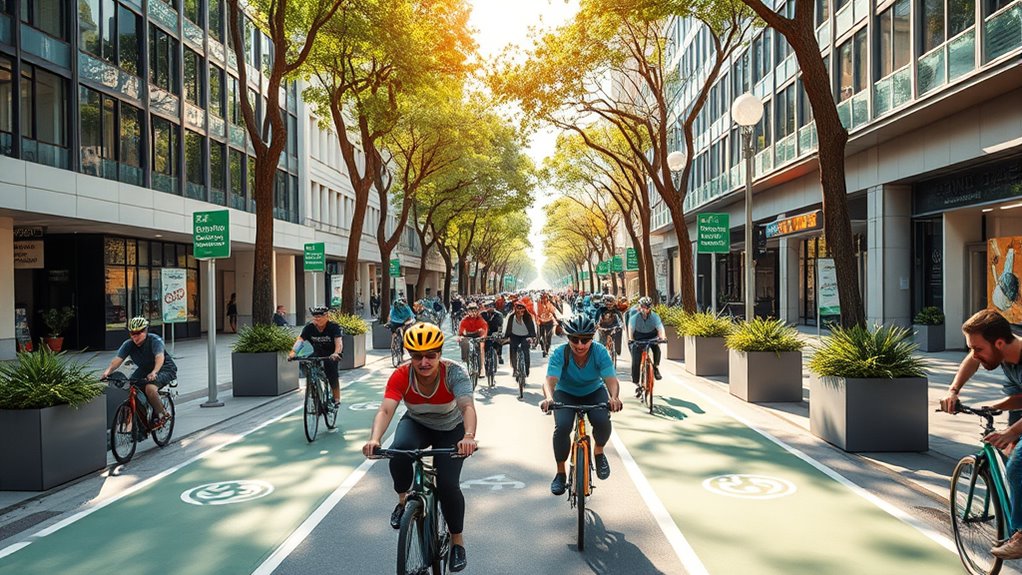
Policy frameworks and regulations set the foundation for encouraging bike use by creating dedicated infrastructure and safety standards. Incentive programs and funding boost adoption by making cycling more accessible and appealing to residents. Community engagement strategies help build support and awareness, ensuring that policies translate into real behavioral change. Additionally, implementing payment solutions that support contactless and mobile transactions can facilitate easier access to cycling-related resources and incentives. Moreover, integrating urban planning principles that prioritize bike-friendly layouts can significantly enhance the effectiveness of these policies. Incorporating infrastructure development strategies ensures that cycling routes are safe and well-connected, further promoting active transportation. Recognizing the benefits of bees for biodiversity can also influence urban green space planning to support pollinator-friendly environments.
Policy Frameworks and Regulations
To promote bicycle adoption, many cities worldwide have implemented targeted policies and regulations that create safer and more accessible environments for cyclists. These cycling policies integrate infrastructure, legal measures, and urban planning to support biking as a sustainable transport option. Governments often introduce incentives like tax benefits, subsidies, or grants to encourage bicycle use. Legal measures, such as protected bike lanes and reduced speed limits, ensure safety and comfort for cyclists. Urban planning efforts align infrastructure development with land use and public transit systems, fostering seamless mobility. Policy frameworks like the European Union’s Urban Mobility Framework and Spain’s National Strategy exemplify extensive approaches. These initiatives aim to increase cycling modal share while promoting environmental and social benefits.
- Development of protected bike lanes and signage
- Incorporation of cycling into urban planning and zoning
- Implementation of legal measures for cyclist safety
- Incentives to promote bicycle ownership and use
Incentive and Funding Programs
Building on efforts to create safer and more accessible cycling environments, incentive and funding programs play a vital role in boosting bicycle adoption. Funding initiatives often include grants for developing cycling infrastructure like protected bike lanes, bike-sharing systems, and secure storage facilities. Government policies in countries such as Spain and Colombia allocate dedicated budgets to promote cycling as part of broader urban mobility strategies. Financial incentives, like tax rebates, subsidies, or bike allowances for employees, encourage more people to choose bicycles for daily commutes. Additionally, international organizations, including the European Union, provide funding and technical support to expand cycling networks and integrate bicycles into urban transit systems. These programs make cycling more practical and attractive, helping cities foster sustainable transportation habits.
Community Engagement Strategies
Community engagement is essential for fostering widespread bicycle adoption, as it guarantees that local residents have a voice in shaping cycling infrastructure and policies. By encouraging community participation, you create inclusive engagement that considers diverse needs, including marginalized groups like women, children, and older adults. Implementing neighborhood Bike Councils and organizing community events like Ciclovia and group rides strengthen social cohesion and promote a cycling culture. Public awareness campaigns and educational workshops help address safety concerns, changing behaviors and increasing participation. Policies offering incentives such as subsidies, tax rebates, or free bike-sharing memberships considerably boost cycling among diverse populations. These strategies ensure that policies are equitable, responsive, and effective in promoting long-term behavioral change, ultimately embedding cycling into the fabric of urban life.
Community Engagement and Successful Case Studies
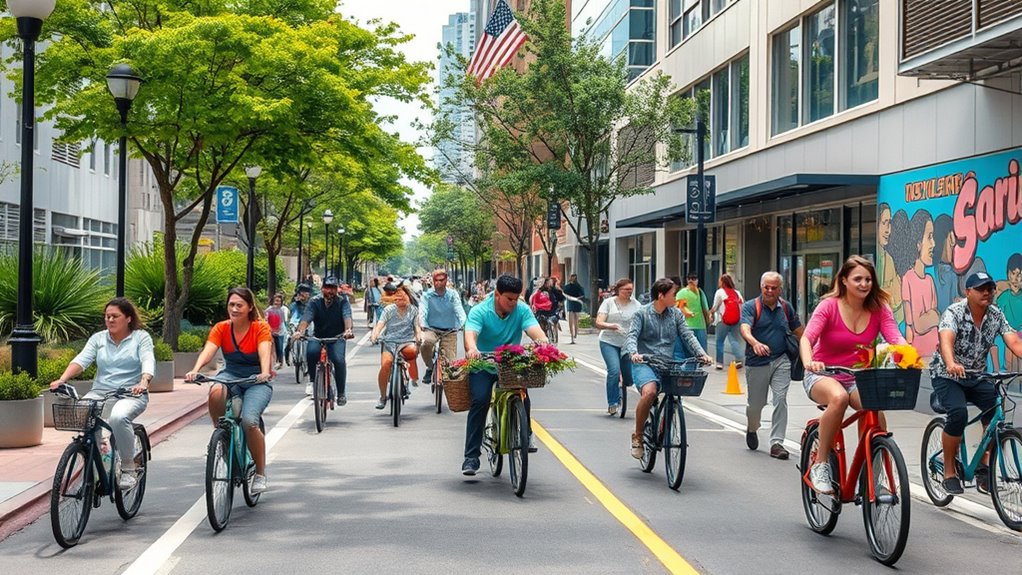
Community engagement plays a vital role in making cycling infrastructure effective and inclusive. Successful examples like Bogotá’s extensive bike lanes and Ciclovia events show how local participation boosts ridership and social cohesion. By adopting inclusive planning approaches, cities can better address diverse needs and create bike-friendly environments that everyone can enjoy.
Inclusive Planning Approaches
Inclusive planning approaches are essential for designing cycling infrastructure that genuinely serves everyone, regardless of age, gender, or ability. By prioritizing inclusive design and active community engagement, you ensure that diverse voices shape policies promoting equitable access and universal accessibility. Successful case studies, like Bogotá’s expansion to over 630 km of protected cycling lanes and extensive bike parking, show how inclusive design boosts participation across all demographics. Incorporating universal design standards and low-cost interventions—such as protected bike lanes and safe intersections—creates streets accessible to all. Engaging local communities through neighborhood Bike Councils and multilingual webinars fosters active participation, helping identify barriers faced by marginalized groups. Data-driven, participatory planning guarantees safer, more equitable urban mobility solutions for everyone.
Notable Global Examples
How have cities around the world successfully integrated community engagement into their cycling initiatives? They’ve done so by prioritizing cycling infrastructure that encourages participation and reflects local needs. Bogotá’s weekly Ciclovía attracts over 1.2 million participants, fostering community involvement and promoting active transportation. Portland incorporates neighborhood bike councils and public consultations, boosting bicycle trips by 7%. Utrecht’s extensive protected bike lanes and parking facilities support a 50% modal share, shaping urban planning that champions cycling. Seville’s large-scale bike-sharing system and expanded segregated lanes increased cycling trips by 300%, reducing emissions and car dependency. Copenhagen’s cultural norm of cycling, supported by infrastructure, has resulted in a 62% modal share. These examples highlight how community engagement leads to more sustainable, inclusive, and effective urban transportation systems.
Community Engagement Strategies
What strategies effectively engage residents in developing cycling infrastructure? You can foster community participation by establishing neighborhood Bike Councils that involve locals in planning and safety initiatives. Large-scale events like Bogotá’s Ciclovia demonstrate how recurring street closures boost public support and encourage active mobility. Educational campaigns and multilingual webinars raise awareness about inclusive cycling infrastructure, making it accessible to marginalized groups. Community-led pilot projects, such as temporary protected bike lanes, build trust and showcase tangible benefits, motivating wider adoption. By actively involving stakeholders and listening to local feedback, you enhance the sustainability of bike-friendly initiatives and notably increase cycling infrastructure usage. These strategies foster a sense of ownership, ensuring long-term success and community buy-in for active mobility projects.
Frequently Asked Questions
Why Are Bicycles One of the Most Sustainable Forms of Transport?
You’re wondering why bicycles are so sustainable. Bicycles produce zero emissions during use, helping cut down greenhouse gases. They need minimal resources to build and maintain, making them efficient. Cycling reduces dependence on fossil fuels, improving air quality. Plus, bikes ease traffic congestion, lowering emissions from cars. By choosing a bike, you actively contribute to a cleaner environment, healthier communities, and a more sustainable urban future.
How Does Cycling Promote Sustainability?
You might think cycling isn’t enough, but it actually promotes sustainability by producing zero emissions, so you’re helping cut air pollution and greenhouse gases. When you ride, you use minimal resources and reduce reliance on fossil fuels, easing traffic congestion and freeing up space for green areas. Plus, cycling keeps you active and healthy, lowering healthcare costs. Your daily ride makes a real difference for a cleaner, greener city.
What Are the Benefits of Using a Bike for Transportation?
Using a bike for transportation offers you numerous benefits. It’s a cost-effective way to get around, saving you money on fuel, parking, and maintenance. Cycling also boosts your physical health, helping you stay active and fit. Plus, it reduces your carbon footprint by producing zero emissions, which is great for the environment. You’ll avoid traffic jams and enjoy a flexible, efficient way to reach your destinations, making your daily commute better all around.
How Does Using Your Bike for Transportation Benefit the Environment?
Imagine cruising through your city, feeling the wind and knowing you’re helping the environment. When you bike instead of drive, you produce zero emissions, cut down on air pollution, and reduce your carbon footprint. Your choice decreases reliance on fossil fuels and eases traffic congestion. By cycling, you actively support cleaner air, healthier cities, and a sustainable future—making a real difference with each pedal stroke.
Conclusion
By embracing bicycles, you contribute to a cleaner, more accessible city. Evidence shows that cities with strong cycling infrastructure reduce pollution and traffic congestion markedly. When you ride, you’re not just improving your health but also supporting sustainable urban growth. The theory that small individual actions can drive big change holds true here—your choice to cycle helps create a more equitable, vibrant, and resilient community for everyone.









